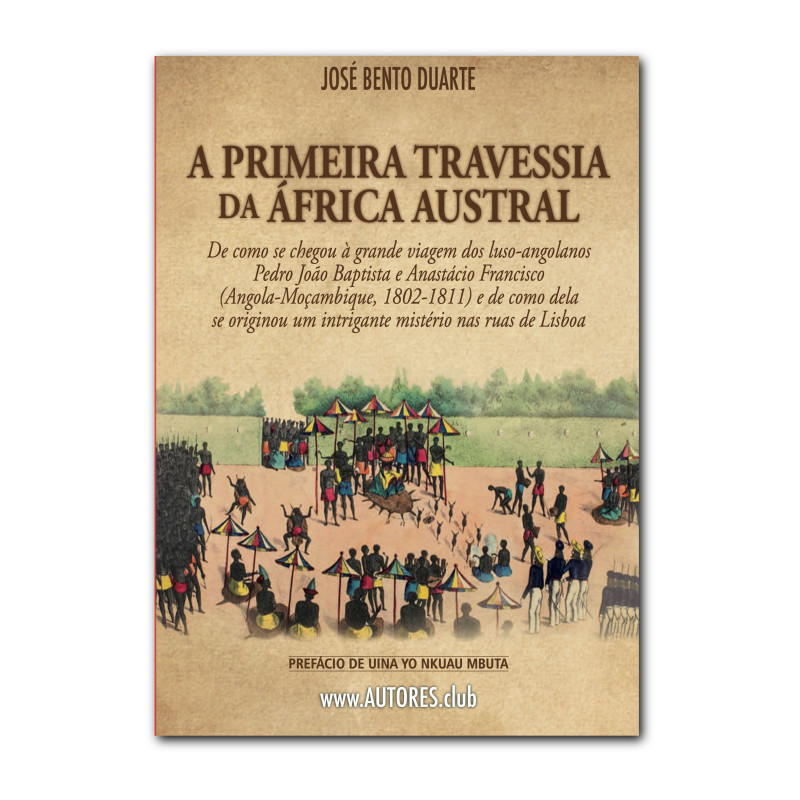



The book The First Crossing of Southern Africa [On how the great journey of the Luso-Angolans Pedro João Baptista and Anastácio Francisco (Angola–Mozambique, 1802–1811) came to be, and how it gave rise to an intriguing mystery in the streets of Lisbon], by José Bento Duarte, has just been published (July 2025) and is now available, offering a relevant contribution to the understanding of the history of African explorations.
Author: José Bento Duarte
Publisher: Perfil Criativo - Edições
Publication Year: July 2025 – 1st Edition
ISBN: 978-989-9209-19-0
Number of Pages: 260
Language: Portuguese
 SECURITY
SECURITY
AUTORES.club uses security measures.
 DELIVERIES
DELIVERIES
Portugal: 4 days; Europe: 10 days; Rest of the world: 20 days.
 RETURNS
RETURNS
You can return your order within 14 days.
(+351) 214,001,788 | encomendas@autores.club
Order from a store near you.
Fnac | Worten | Wook | Bertrand | Promobooks
The book highlights an extraordinary achievement, long ignored or underestimated: the crossing made at the beginning of the 19th century by two Angolan pombeiros — Pedro João Baptista and Anastácio Francisco — from the Malanje plateau (Angola) to the Tete plateau (Mozambique). A journey of more than eight years through the heart of the continent, it must now be recognized as a pioneering and unforgettable milestone of courage, tenacity, and mission spirit carried out by two unlikely and, at the time, wholly unexpected agents.
The publication comes at a moment rich in symbolism: fifty years since Angola's independence, fifty-one years since the Carnation Revolution (which ushered in democracy in Portugal), and in a time of renewed debate about colonial legacies, historical memory, and the recognition of African protagonists in global narratives. In line with the African Union's theme for 2025 — Justice, not necessarily material, for Africans and people of African descent — José Bento Duarte’s book gains even greater relevance and urgency. More than a chronological account, the book is a rigorously documented analytical essay, built on the investigation of a wide range of historical sources.
With a preface signed by Uina yo Nkuau Mbuta (the Kikongo name of Prof. Dr. Carlos Mariano Manuel, physician, researcher, and recipient of the 2023 Lusophone Personality Award), the book unfolds across a structure of twenty-one chapters. It begins by examining mythical conceptions of the African continent developed in Antiquity and reinforced during the Middle Ages — perceptions that would weigh heavily on later historical events. It then explores the early contacts between the Portuguese and Africans, the gradual colonial occupation of Africa’s coasts from the 15th to the 19th centuries, the attempts to penetrate the interior, and the broader evolution of political conditions that would ultimately lead to the hazardous, dramatic, yet triumphant journey of the two pombeiros.
CONTENTS
PREFACE
INTRODUCTION
Chapter 1 — African Enigmas
Chapter 2 — Cannibals, Terrors, and Prejudices
Chapter 3 — Portugal, Castile, and the Assault on Morocco
Chapter 4 — Henry, Pedro, and the Overseas Routes
Chapter 5 — First Atlantic Advances
Chapter 6 — Beyond Cape Bojador
Chapter 7 — Encounters and Misunderstandings in Guinea
Chapter 8 — King João II, the Mina, and the “India Plan”
Chapter 9 — Zaire: The Gates of Hope
Chapter 10 — Congo: The Missed Opportunity
Chapter 11 — The Elusive Lands of Ndongo
Chapter 12 — The Donation (September 19, 1571)
Chapter 13 — The Futile Dream of Paulo de Novais
Chapter 14 — Settling in Angola
Chapter 15 — The Indian Seas
Chapter 16 — The Calicut Tragedy
Chapter 17 — Along the East African Coast
Chapter 18 — Settling in Mozambique
Chapter 19 — Preparing the Crossing: Correia Leitão in Cassange
Chapter 20 — Lacerda e Almeida and the Fatal Barrier of Cazembe
Chapter 21 — The Crossing of Pedro João Baptista and Anastácio Francisco
CONCLUSION — A Mystery in the Streets of Lisbon
APPENDICES
BIBLIOGRAPHICAL NOTES
BIBLIOGRAPHY
You may also like